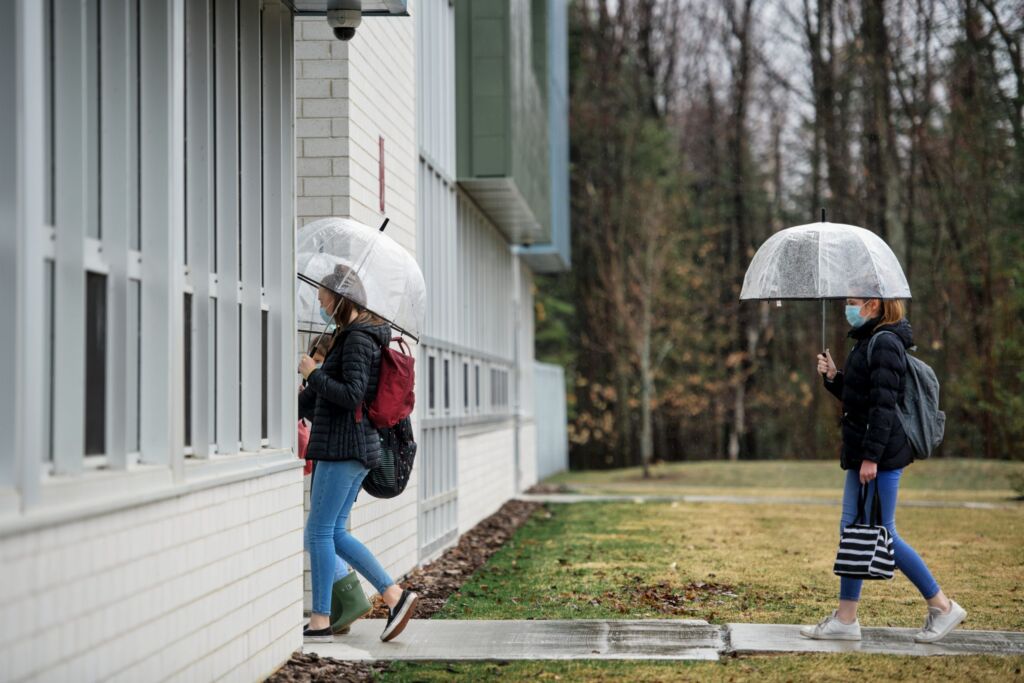As the back-to-school terrain and announcements shift, fear and anxiety continue to rise.
Second-guesswork, anxiety and wanting what’s best for your child are the great parental equalizers. What parents are able to do to mitigate that, however, is not equal—not by a long shot.
It shouldn’t be lost on anyone that the “solutions” being touted by the provincial government—what they’re prepared to prioritize—look an awful lot like what they were demanding during the last round of bargaining, which was soundly rejected by the majority of the public: larger classes, less face-to-face contact with educators, mandatory online learning, inadequate resources to meet kids’ needs.
The stakes are incredibly high, and we need to invest thoughtfully and adequately in the entire system so those with fewer choices are not forced to gamble on the health of their family, their job status or their child’s education.
Educational inequity predates COVID-19…
The COVID-19 shutdown created inequities, but it also exacerbated and revealed preexisting ones. The reopening has too, with an increased health risk for some workers over others. All of this is magnified when we are talking about our public schools, which are at once places of work, places of learning, places of care, and serve as community hubs across the province.
This means we need to address not just COVID-related inequity, but the decades of inequity created by systemic underfunding. Ontario’s current funding formula does not meet the needs of kids, it by design pulls money out of the public system, and it pits various aspects against each other (e.g. teacher salaries vs leaky roofs vs ESL). The impact isn’t shared equally. Parents with means can always fill in the gaps at their local school. Wealthy communities can and do fundraise much more to enhance the programming their schools provide, with school councils more likely to have parents with professional experience in fundraising or accounting, or who simply have more available time to volunteer.
But without sufficient public funding, cracks across the system begin to show—the cost of deferred maintenance is now clocking in at over $16B, and rising.This is something that all of the fundraising done by parents, or extra hours, pocket change, lunches and bus fare volunteered or donated by educators and education workers cannot compensate for.
...But COVID-19 both deepened and highlighted existing cracks in the system.
When they are properly funded, public services—like education—are incredibly well-positioned to address and compensate for, even counteract, socioeconomic inequities because they are designed to meet the needs of those who use them. But when they are underfunded, and operate from a position of scarcity, they reinforce those same inequities, disproportionately impacting kids who are from marginalized communities.
Back in March when school buildings were shuttered and learning went virtual, we really noticed the gaps that, even underfunded, public education once compensated for. This was in no small part because of all the extra unpaid work and fundraising and community engagement that so much of the system has had to rely on even as resources grew less and less adequate. Which is why schools and boards spent the first few weeks of the shutdown arranging how to get school resources, library books and Chromebooks to students who needed them, and WiFi access in all sorts of creative (and sometimes clumsy) ways when schools and libraries were no longer available.
Ok but can’t parents just keep their kids at home if they worry about their safety?
Parents, education sector employees and public education advocates are concerned that the province is not funding for a safe reopening. Physical distancing guidelines are less stringent than what is being advised in other workplaces; many classes are larger than people were led to believe they would be; online learning seems less than adequately thought through. That’s the thing about online learning—it works fine for some kids who are self-starters and love to work independently. It works….less well for lots of kids. And it doesn’t work at all for some. It also creates new issues: remote learning makes it much more difficult for educators to identify kids who are becoming disengaged and need extra help, let alone trying to determine why.
The choice to work from home is not something afforded to all parents, workers or sectors. But it’s widely recognized that for those families who can explore this option, it’s a cost largely borne by women through unpaid work, dropping out of the labour force or taking a cut in hours. The choice to hire a tutor to augment what their child is learning even if they attend school in-person is not something all parents can contemplate.
Doesn’t “going private” (for those who have the means) leave more resources for kids who “really need them”?
Concerned with safety, or with the pedagogical impacts of the current plan, some parents are choosing to form learning pods with friends, sharing the supervision of a group of kids’ online learning. Others are hiring private teachers and charging tuition fees. Established edu-businesses are getting into the action. Some workplaces are setting themselves up as pods/private schools, in some cases to offset income lost during the shutdown. But again, this is thoroughly privilege-based.
And it’s a spiral—parents pull kids out of the system due to understandable anxiety, suggesting that this leaves more “resources” for the kids who “really need them.” This is not a new justification, by the way—it underpins much of the Trojan Horse school choice movement that neatly substitutes “publicly funded” for “public education”. And as we’ve seen in other jurisdictions including Ontario it actually results in possibly slightly smaller classes being collapsed into even larger ones, with fewer educators, less support, less resources, and a continually underfunded system that does not inspire confidence.
It’s only a matter of time before proponents of the “school choice” movement, or those capitalizing from it, demand some sort of compensation for the extra dollars some parents are putting into their child’s individual learning. Which is precisely what leads to charter schools or vouchers, or other public subsidies for private choices. Again, the choices we’re told parents can make aren’t cheap. And they’re certainly not neutral or without consequences.
So what’s the option? Everyone stay home?
To be clear, schools do need to reopen. Kids who are in a position to do so need to go back. Educators want to work, and parents want to work. Isolation has created a mental health crisis we’re only beginning to grasp. But we have to do it safely. Smaller classes. Centring kids’ needs. Recognizing one size never fits all, but especially not now. We need to ensure the system can accommodate people who will be absent because they are sick or have been exposed, people who have to quarantine, while addressing the need for more cleaning, more mental health supports, more testing, more tracing, and ending movement between schools.
We can either pay to shock-proof the system (through well-funded social and physical infrastructure including testing, tracking and tracing, income supports and paid sick days for those who need them), or pay people to stay home to keep them safe. Both options are expensive, but one is, at least on a permanent basis and by definition, unworkable.
The province’s actions to guarantee a #SafeSeptemberON are significantly less than what advocates say is adequate. It’s also certainly less than the government claims it is spending. And the result has been increased anxiety about health implications, along with concern about what this means for public education as class sizes grow, resources diminish, curriculum is scaled back, and people lose faith in the system’s ability to meet their kids’ needs. It further reveals the cold calculus of who and what those in power consider dispensable.
During times of uncertainty, and in the absence of a structure that serves everyone well, people can gravitate to what and who is familiar. But this reinforces difference and division. When it’s about money—and when it is not? — it deepens the socioeconomic inequities that were already present. The solution to our collective problems will never be achieved through prioritizing individual preferences.
Erika Shaker is the Director of the CCPA National Office and Editor of Our Schools / Our Selves. She is on Twitter at @ErikaShaker.







